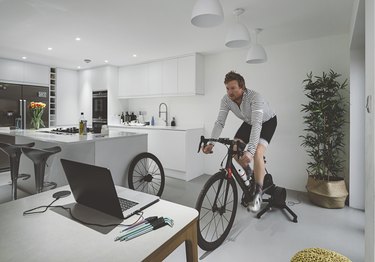
There's nothing quite like the heart-pounding, sweat-drenching feeling you get after pedaling through the final hill interval of an indoor cycling workout. The sense of accomplishment and killer quad pump make enduring high-intensity intervals worth every minute of hard work.
And since you can easily adjust all the variables that create intensity and allow for recovery, indoor cycling is a great modality for HIIT workouts, says Emily Booth, the education manager for cycle and group fitness at Life Time.
Video of the Day
Video of the Day
To incorporate HIIT into your next indoor cycling workout, check out our expert-approved tips and sample beginner-friendly workout.
Benefits of Indoor Cycling HIIT Workouts
High-intensity-interval training (HIIT) is a training method that alternates short bursts of near-maximum effort with rest periods. Applying this method to cycling helps increase your endurance and power on the bike.
Plus, it's a good option if you're looking to avoid the impact that often comes with other HIIT workouts. "When you take HIIT to a bike, you reap the same benefits without the added stress of impact on your body's joints, making HIIT cycling workouts well suited for a person of any age," says Lauren "Lolo" Wilson, senior master instructor for CycleBar.
Other benefits include improved oxygen consumption and aerobic capacity, increased calorie burn in a short amount of time and an increase in the effect of EPOC or excess post-exercise oxygen consumption, which helps to burn calories even after you're done working out.
Related Reading
Tips for Your Best Indoor Cycling HIIT Workout
Before you get in the saddle, there are some basic guidelines that apply to all fitness levels. These tips will also help you stay motivated as your cycling workouts take off.
- Go easy in the beginning. Whether you're new to exercise or you're coming back from a fitness hiatus, the best thing you can do is ease into exercise. HIIT workouts are very demanding, so it's important to start out slowly, Booth says.
- Think quality over quantity. "Ideally, you should start with one or two HIIT cycling workouts per week that are 30 to 45 minutes in length," Wilson says. When you feel ready to add more, the next step is to strive for consistency. After three to four weeks, Wilson recommends increasing your sessions to two to four times a week for 45 to 60 minutes each.
- Don't skip the warm-up. As tempting as it may be to jump right into the harder intervals, taking enough time to warm up will make a difference in the quality of your workout. Aim for a thorough warm-up of about 10 minutes before you build into the power of the intervals, Booth says.
- Focus on intensity. To gain the benefits of a HIIT cycling workout, it's crucial to perform the intervals at a very high intensity, Booth says. Which also means it's essential to allow for full recovery between sessions and never perform workouts on consecutive days.
Try This Indoor Cycling HIIT Workout for Beginners
Pedaling is the easy part. Knowing what to do once you break a slight sweat is where things can become challenging. That's why having a plan before getting in the saddle is so important.
For this workout from Booth, you'll be increasing speed and resistance, so you may need to experiment with both until you find what you can sustain for one minute that feels challenging but doable.
Exactly how much you increase your resistance and revolutions per minute (RPM — think of it as your leg speed) depends on your fitness level. Consider increasing the resistance anywhere from two to five levels to start. Your leg speed can jump up by 10 to 20 RPM, but on average, your RPM will range from 60 to 90, depending on the resistance and interval.
Step 1: Warm Up
- Warm up with easy pedaling, gradually increasing your heart rate for five minutes.
- You should begin to feel the intensity increase and your body heat up, but you shouldn't be working so hard that it's tough to talk.
Step 2: Alternate High-Intensity Work and Recovery
- After the warm-up, increase both resistance and speed (RPM) and push as hard as possible for one minute.
- Recover at your warm-up pace for two minutes.
- Continue alternating for a total of 15 minutes.
Step 3: Cool Down
- Bring your heart rate back down with five minutes of easy pedaling.